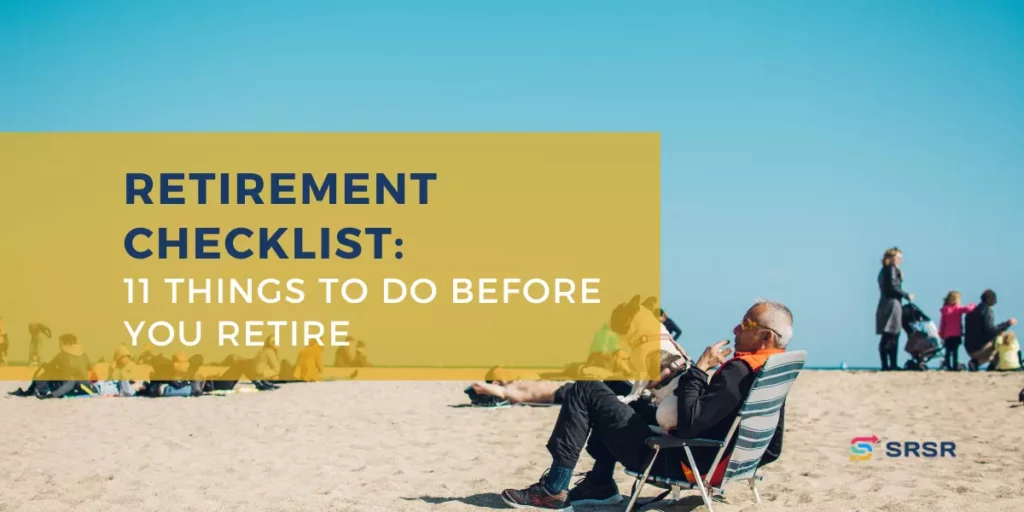Ready to retire? Do these 11 things first
Retirement is likely one of the biggest life changes you’ll ever face. It is a significant milestone in life, and creating a retirement plan for it is crucial to ensure that you can enjoy your golden years with peace of mind. Just like how businesses need to plan for their long-term success, individuals also need to think ahead to make their retirement comfortable and fulfilling. You can make the transition go smoothly by ticking off these 11 things from your retirement checklist before you retire.

1. Apply for Social Security
Social Security may replace a significant portion of your preretirement income. Social Security is a federal government program that provides monthly income for those who qualify. Monthly income benefits are based on lifetime earnings, retirement age, and other factors. For retirees, earnings over the year, retirement age, and other factors impact their income. The income provided by Social Security is inflation adjusted each year.
You can start collecting as early as age 62 or wait until you’re older. The Social Security Administration (SSA) considers your age when determining your monthly check amount, and the amount you receive will typically increase the longer you delay (up to age 70). Use the SSA’s benefits calculator to estimate how much to expect each month, then apply for benefits.
2. Sign up for Medicare
When it comes to retirement planning, healthcare expenses are one of the largest expenses retirees may face. That’s where Medicare comes in. Medicare is a federal health insurance program that primarily covers individuals who are 65 or older, but also covers some people with disabilities and people with End-Stage Renal Disease (ESRD). The program has several different parts that cover different types of healthcare services, including hospital stays, doctor visits, prescription drugs, and more. If you’re 65 or older when you retire, you’ll rely on Medicare for health insurance. Before signing up, learn about Medicare’s four parts, what each covers, when to apply, and how much you’ll pay in premiums. You should also ask your current doctors if they accept Medicare. Once you’re ready, sign up for Medicare online.
Eligibility Criteria:
To be eligible for Medicare, you must be a U.S. citizen or legal resident who has lived in the United States for at least five years and has paid Medicare taxes for at least ten years. While Medicare covers many healthcare services, there may be out-of-pocket costs for some services. To help cover these costs, you may want to consider purchasing a Medicare Supplement Insurance (Medigap) policy, which is offered by private insurance companies.
3. Review your estate plan

A solid estate plan ensures your assets are distributed according to your wishes. It should include an updated will, power of attorney, and advanced medical directive. Before you retire, it’s imperative that everything is in order and that you’ve updated your beneficiaries. Schedule time with an estate planning attorney to review your plan.
4. Review your retirement portfolio
Plan your retirement goals and meet with a certified financial planner (CFP) to ensure you’ll generate enough income to sustain your desired lifestyle.

A CFP can also help ensure that your retirement portfolio is appropriately diversified. Diversification means holding different investment types (including stocks, bonds, real estate, and more) in various industries. A diversified portfolio provides a dependable income stream without fluctuating too much.
5. Create a realistic retirement budget
Put together a detailed monthly budget to estimate your expenses during your first year of retirement. Your budget should include your monthly income, expenses, and debt obligations.
By creating a realistic budget, you’ll know how much to withdraw from your retirement accounts each month while taking required minimum distributions (RMDs) into account. If you can afford to receive a smaller monthly amount than you initially thought, consider keeping money in your tax-advantaged retirement accounts to continue investing. On the other hand, if you will not have enough income to cover expenses, you’ll know whether to postpone retirement or rework your budget.
To learn more, read “How To Create Your Retirement Plan.”
6. Review your retirement income sources
List all potential income sources to ensure you’ll have enough money to support your retirement budget. These sources could include Social Security, dividends, pensions, rental properties, and RMDs from retirement accounts.
For each potential income stream, you should understand when you can access funds, how to withdraw from your accounts, how predictable the monthly amount will be, and how each income source will be taxed. You should also identify which sources are indexed for inflation to protect you from losing purchasing power. For example, your Social Security income may adjust annually to keep up with rising living costs.
To learn more, read “How To Create a Retirement Income Strategy.”
7. Review your retirement expenses
After you’ve created a retirement budget, you’ll want to closely examine your expenses and separate them into fixed and variable costs.
Fixed expenses are typically the same month to month and are generally required payments. They include things like mortgages, property taxes, and insurance premiums. Variable expenses, on the other hand, change quickly and frequently and are usually things you pay for as you go. They include electricity costs, groceries, dining out, and vacation costs.
By separating your fixed and variable expenses, you’ll know which costs you can eliminate or reduce if something unexpected occurs or you need to change your spending habits in retirement.
8. Build your emergency fund
Once you’re retired and living on a fixed income, you will likely need a bigger cash reserve to help with emergencies and fluctuations in the market. You should try to save at least two years’ worth of living expenses saved in an emergency fund to pay for a new roof, car repairs, medical expenses, or other unexpected needs that may come up during retirement. Put this money in a separate savings account so you’re not tempted to spend it if it’s unnecessary.
9. Pay off debt
Ideally, you’ll retire without debt, but if you still have debt, start paying down any debts with higher interest rates, like credit cards. Pay off your mortgage last because it likely has the lowest interest rate.
10. Consider downsizing
Moving into a smaller living space (such as an apartment, townhouse, condo, or smaller home) can greatly benefit you during your retirement years. A smaller residence will likely mean fewer expenses, including mortgage payments, property taxes, utility costs, and more. Downsizing may also allow you to cut back on maintenance and upkeep services like lawn care.
11. Evaluate an AARP membership
AARP is a nonprofit organization that caters to older people looking for discounts, financial guidance, and a sense of community. They offer an annual membership that provides access to in-depth information about Social Security, activities to stimulate brain health, and money tools to help you manage your finances during retirement.
When you sign up, you’ll also receive discounts on travel, restaurants, delivery services, health and wellness products, and more. In short, AARP can be a valuable resource during retirement. Carefully consider the benefits of an AARP membership to determine if the cost is worth it for you.
Ready to take the next step?
When creating your retirement budget and looking for ways to lower expenses, consider moving to a state with a lower cost of living or taxes. To review your options, read our article “The Best States to Retire.”

